Happy customers lead to happy shareholders – happiness is contagious, so why aren’t more businesses focussed on return on happiness (ROH)?
‘What’s the ROI on this initiative?’ is generally one of the first questions asked by every company every day. And indeed, we ask our clients this right off the bat to gauge expectations and desired results. The logic is, happy customers mean loyal customers, which translates to more revenue and market share.
In the first instance, put yourselves in the hot seat. When you are thinking about buying a product or service how much does the rating and review influence your purchase decision? We’d hazard a guess that its sphere of influence is far-reaching on your decision making. So, why don’t companies don’t focus more on the return on happiness as a metric?
By focusing on return on happiness as a key metric, you’re really focused on understanding your customers’ journey – because your customers offer a holistic picture into the world you’re operating in. Assessing and understanding your customers’ pain points, wants and needs via a 360° perspective into their behavioural tendencies and the choices they make, you save yourself from stabbing in the dark – thus, it leads to more effective business, and ultimately a happier and more loyal customer.
This is where digital transformation swoops in. Organizational digital maturity is based on several phases, based on our experience in leading digital processing for large Fortune 500 companies, such as Gillette, P&G, GSK and Pfizer. When digital transformation starts to save and make money for companies at scale, that’s when it moves into the C-suite zone.
However, the problem occurs when organizational structures don’t let shift happen or they are looking at instant success or ROI. A common issue many companies face is running before they can walk.
When challenged on the ROI of current investments the excuse is we have historical data. However historical data unfortunately doesn’t give you a guarantee of the future. Real-time qualitative data, does. Mining qualitative data is a major part of digital/business transformation.
Some companies, in their bid to try and normalize digital, ignore the fact that digital consequently creates a ‘new normal’ and requires a significant restructure and realignment. Having a Chief Digital Officer sit across sales and marketing, who is also responsible for all technology decisions, is now a standard requirement.
The challenge at every level in every organization is facing the inevitable question: ‘Do I have the right skills to drive business transformation in the digital world?’
What does that mean? What is the impact? When will it happen?
As the majority of companies are still run by analogue leaders these questions are not answered or decisions are half backed.
Most digital transformations fail, as a result.
People have short term memory with a focus on the ‘now’ short-term results and thus sacrificing long-term growth. Our approach is strategic and based on long-term growth, sustainability and legacy building, which ensures longevity and accuracy. Our future predictive forecasting captures the most up-to-date consumer buying habits, their will to spend and most importantly ‘why’. Shift is constantly happening. The world is in flux more than ever. Therefore, maintaining a static position would be a myopic, unyielding move.
At a time when digital disruption of consumer behavior is changing how customers want to engage, it’s becoming even more important for organizations to focus on return on happiness as a key metric of success for the best conversion possible.














